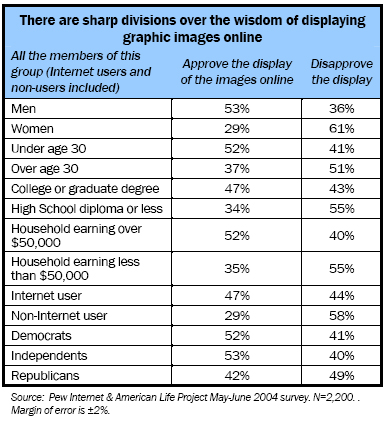Americans are turning to the Internet for news coverage they can’t find in the mainstream news media.
During recent months, a significant number of Americans have been turning to the Internet as a source of news and pictures that are not available in the mainstream media. This has come at a time of intense and dramatic news coverage that includes an unprecedented volume of references to disturbing images from the war in Iraq.
About one quarter of Internet users say they have gone online at one time or another for news that was not covered by the mainstream press; 24% of Internet users say they have searched on the Internet for news stories, photographs or videos that other media outlets have decided not to publish or broadcast.
Further, with respect to specific coverage of the war in Iraq, 24% of Internet users have seen war images on the Internet that were deemed too graphic or disturbing to be shown on television or in newspapers. Of those who have seen such images, 28% said they actively sought out these images. The rest say they happened upon the images while they were doing something else online.
There are cultural schisms over whether the most graphic images should be available online.
There is a sharp cultural and values divide over the publication of the most graphic war-related images. Overall, 49% of all Americans disapproved of those images being available on the Internet, compared to 40% who approve of those images being shown.
Among segments of the population, a major values gap emerges. Men approve the idea of graphic and disturbing war-related pictures being made available online by a margin of 53%-36%. Women, on the other hand, disapprove of their availability online by a 61%-29% gap.
Another stark opinion gap exists when it comes to age. Younger Americans, those 18 – 29 years old, approve of graphic images being available online by a 52% – 41% margin. Americans who are 30 – 49 years old disapprove by a 47% – 44% margin, and those who are over 50 years old disapprove by a 56% – 31% margin.
Those at the higher end of the socioeconomic scale are more approving of graphic images being available online. Those with at least some college approve of the images being available by a 47% – 43% margin, compared to those with less education, who disapprove by a 55% -34% margin. Those who earn at least $50,000 per year approve of the images being available online by a 52%-40% margin, compared to those who earn less, who disapprove by a 55%-35% margin.

Another division exists between Internet users and non-users. By a 47%-44% margin, Internet users support the idea of those pictures being available online, while non-users overwhelming opposed the posting of those pictures by a 58%-29% margin
Political partisanship also makes a difference, albeit a smaller one. Democrats approve of graphic images being available online by a margin of 52% to 41%; Independents approve by a margin of 53% to 40%. Republicans, on the other hand, disapprove of these images being available by a margin of 49% to 42%.
The experience of viewing the disturbing images online is both positive and painful.
Almost one quarter of Internet users have actually seen the graphic and disturbing war images that appear only online. They come away from the experience of mixed mind: 51% of those Internet users felt they had made a good decision in looking at the images, 33% wish they hadn’t seen them, and 7% volunteered that both of these impressions were true for them.
One cohort, women, stood out from the rest as more than half responded negatively to both questions we posed. Of the 16% of women who have seen the war images online, only 36% say they felt they made a good decision in doing so; 52% said they wish they hadn’t seen them, and 3% said both.


